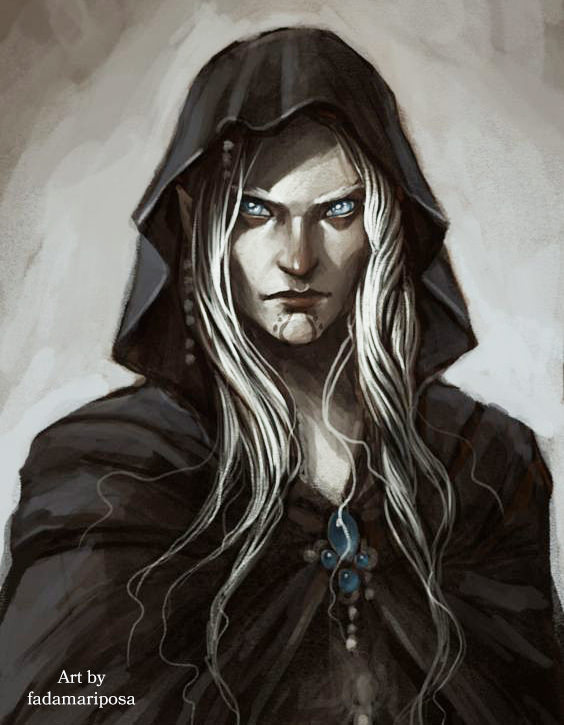Creatures of the Night
This supplement offers a number of racial options for players who wish to have a character with a darker side. These options can be especially useful for gothic horror campaigns like Curse of Strahd.
Some of the races within this supplement are inherently difficult to balance because they are based off of creatures that are naturally stronger than the races in the Player’s Handbook. As such, compromises had to be made in order to maintain a balance of flavor and power. Eleazzaar’s “Detect Balance: a 5e Homebrew Race Guide” has been used as a base guide for this process, with other factors also in consideration.
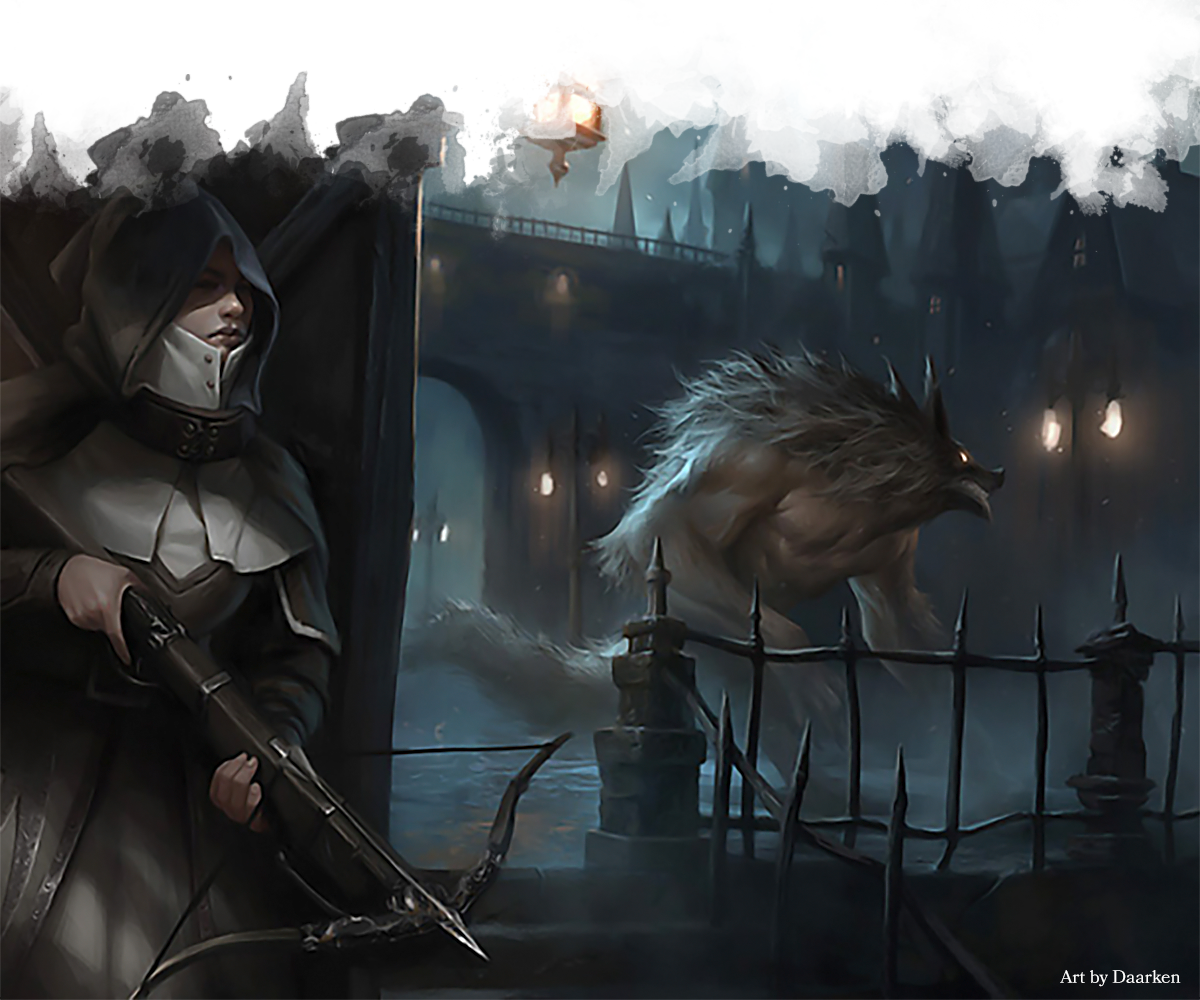
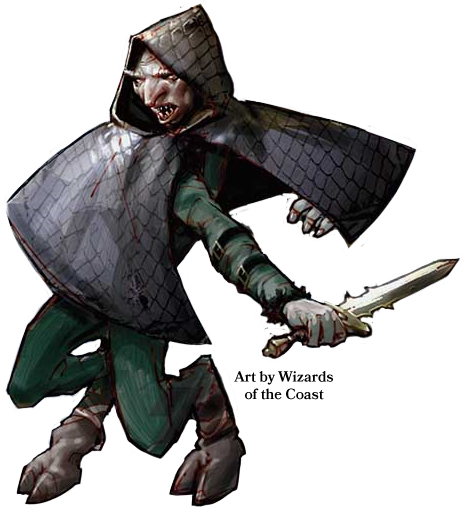
Darkling
Darklings are fey whose ancestors betrayed the Summer Queen, who then cursed these fey to absorb light with their bodies whenever they come in contact with it. This causes darklings to have a short life span. When they die, the light stored in them explodes in a blinding flash. Shunned by other fey and forced to live on the edges of society, they have a reputation for being both stealthy and lethal. Darklings typically have an appreciation for art and beauty. Since many of them eek out a living as thieves or assassins, they may acquire aesthetically pleasing things over the course of their career.
Darkling Traits
The following traits are shared by player characters who are darklings.
Ability Score Increase. You Dexterity score increases by 2.
Age. Due to their curse, darklings age faster and die younger than other fey. They reach adulthood around the age of 8, and typically live for up to 25 years.
Alignment. Darklings usually live among the less savory parts of the underworld, thus tend toward chaotic alignments.
Size. Darklings are between 3 ½ and 4 ½ feet tall, and an average of about 50 pounds. You size is Small.
Speed. Your base walking speed is 30 feet.
Shadowy Camouflage. You have advantage on Dexterity (Stealth) checks to hide in dim light or darkness.
Superior Darkvision. You can see in dim light within 120 of you as if it were bright light, and and in darkness as if it were dim light. You can’t discern color in darkness, only shades of grey.
Blindsight. Your aversion to light has led to a lessened dependance on sight as a whole. You have blindsight out to a range of 30 feet.
Light Sensitivity. While in bright light, you have disadvantage on attack rolls. As well as on Wisdom (Perception) checks that rely on sight.
Blinding Flash. When you are reduced to 0 hit points, nonmagical light flashes out from you in a 10-foot radius. Any creature that can see the bright light must succeed on a DC 10 Constitution saving throw or be blinded until the end of its next turn.
Hybrid Nature. You have two creature types: humanoid and fey. You can be affected by a game effect if it works on either of your creature types.
Languages. You can read, write, and speak Common, and Sylvan.
Restless Spirit
Sometimes, the soul of a creature does not pass into its respective afterlife upon death. The spirit may be bound to the material plane for a variety of reasons. Often, a soul cannot rest because it has unfinished business from life, such as an oath they have yet to fulfill, or because they are sustained by their hatred. Other times, they are kept in the material plane by a necromancer, or an otherworldly power with its own machinations.
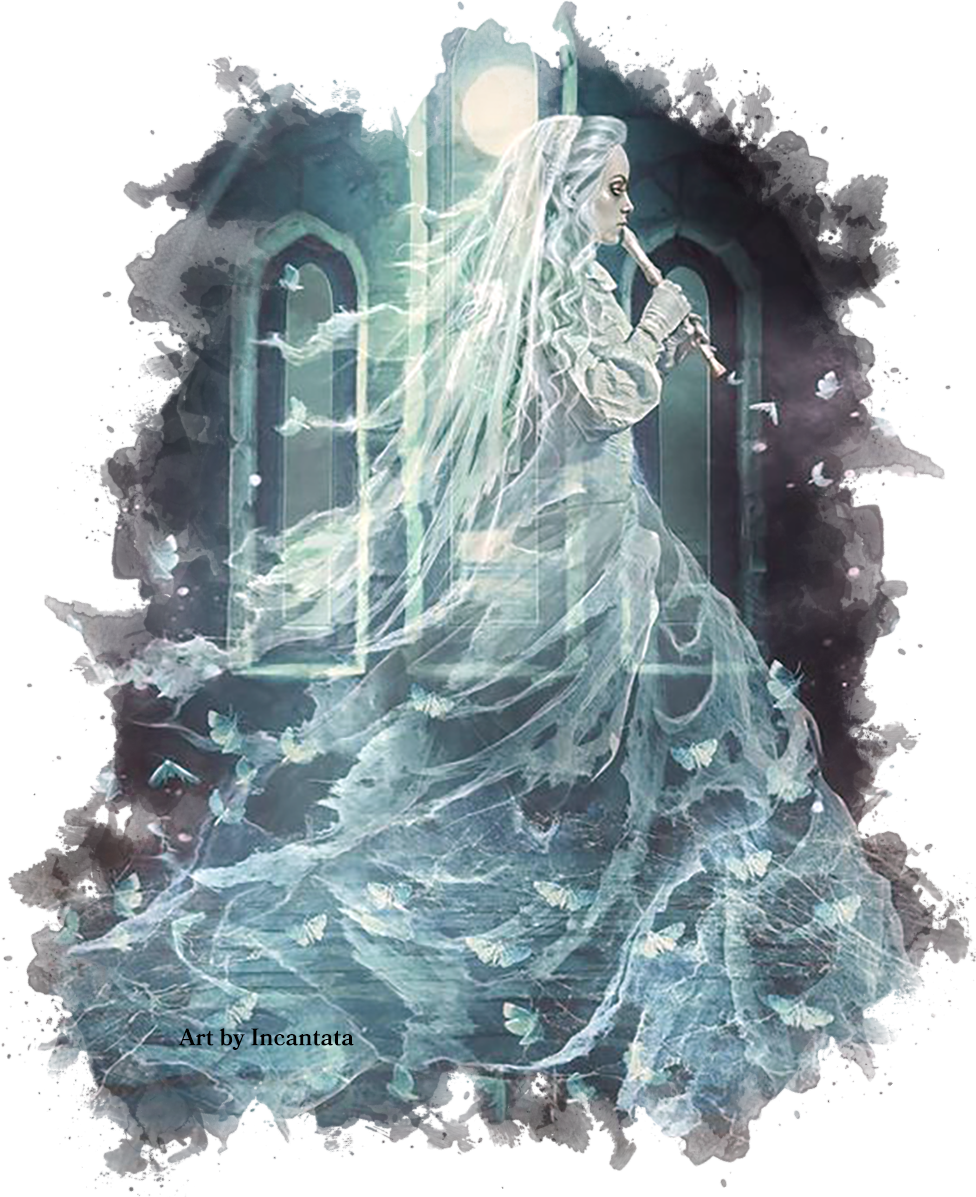
New Reality
Restless spirits have a very different experience of the world than living people. Although a spirit can be affected by physical things on the material plane, their grasp on them is much weaker. Instead, the intent and symbolism behind things on the material plane have a real power of their own to a spirit. For example, while a spirit is physically capable of passing through a wall, it may not be able to do so because a wall is a barrier that represents the intent to keep things out. Likewise, a knife passing through a spirit should not actually harm it, but the intent to harm from its wielder makes the attack harmful, causing the spirit to be disrupted. The stronger a spirit’s ties to the material world, the more it is affected by things on it.
Power in Memory
Unless a restless spirit is kept on the material plane with some form of magic, its anchor to the world of the living are its memories. A spirit without access to the memories can fade and lose its identity, eventually becoming a specter– a feral, tormented spirit that is bound to the material plane until destroyed. When a spirit reestablishes connection to its past life, it becomes more potent and aware. This might be achieved by the spirit discovering things that trigger its past memories. The visitation of a significant person from its past can be an especially powerful reminder. Even creating new memories from new experiences can strengthen a spirit, but that can be rare since spirits have a tendency to haunt the same place. There are legends of spirits whose memories became strong enough to the point where they took on a fully corporeal form once again.
Restless Spirit Traits
The following traits are shared by player characters who are restless spirits.
Ability Score Increase. Your Dexterity and Charisma scores each increase by 1. Your Strength score is reduced by 2.
Negative Ability Scores
Penalties to a creature’s ability scores are generally avoided in 5th edition for a number of reasons, which include balance and accessibility. Like the kobold in Volo’s Guide to Monsters, the restless spirit is an exception to this. The penalty was implemented because it added to the race’s flavor by reinforcing the sense that the spirit does not have as solid of a grasp on the world. It also has the benefit of introducing some drawback to a race that has some innate advantages in certain circumstances.
Age. Restless spirits exist after life, appearing as a they did at a single point in their life (often when they died or were in their prime). Their can exist on the material plane as long as whatever keeps them from resting remains an issue.
Alignment. Any type of person can experience unrest upon death. Some spirits are tormented and seeks to bring suffering upon the living, but many have no such machinations
Size. Restless spirits have the same size and build as whatever your race was in life. Your size is Medium.
Speed. Your base walking speed is 30 feet.
Darkvision. You have superior vision in dark and dim conditions. You can see in dim light within 60 feet of you as if it were bright light, and in darkness as if it were dim light. You can’t discern color in darkness, only shades of gray.
Deathly Resilience. You have advantage on saving throws against being poisoned and you have resistance against poison damage.
Unliving. You are immune to diseases, and you don’t need to breathe, eat, or drink.
Float. You have a flying speed equal to your walking speed, but cannot ascend any higher than 1 foot off the ground with this ability.
Incorporeal self. You cannot be knocked prone, and have advantage on Dexterity checks and saving throws to escape grappled and restrained conditions. Conversely, you have disadvantage when attempting to grapple or shove a creature.
Hybrid Nature. You have two creature types: humanoid and undead. You can be affected by a game effect if it works on either of your creature types, with the exception of if you use a class ability that lets you turn undead. If you are targeted by a cleric’s destroy undead ability and you fail your saving throw, you are turned rather than destroyed.
Languages. You can speak, read, and write Common plus one other language of your choice.
Subrace. There are two subraces of restless spirits: banshees and ghosts. The differences arise from both who the spirits were in life and how they died.
Banshee
Certain spirits are bound to the material plane by the deeds that they themselves committed in life. Most banshees exist because they were elven women who used their beauty to exploit others. These banshees have an immense fascination with beauty and objects that symbolize beauty, and a tendency to hoard said objects. However, they abor mirrors and can’t stand to see their own reflection.
There are also rarer accounts of non-elves turning into spirits with banshee-like abilities by deeds they regret in the afterlife. In all cases, these spirits exude an aura of sadness and are prone to weeping as they prowl the material world. When a banshee wails, it tears at the souls of the living, often killing them outright.
Wail. You can use your action to let out a soul-rending shriek. This ability has no effect on constructs or undead. All other creatures within 30 feet of you that can hear you must make a Constitution saving throw with a DC equal to 8 + your proficiency bonus + your Charisma modifier. A creature takes 3d6 psychic damage on a failed save, or half as much damage on a successful one. The damage increases to 5d6 at 6th level, 7d6 at 11th level, and 9d6 at 16th level.
After you use your wail, you can’t use it again until you complete a long rest.
Ghost
Ghosts are what most people imagine when they think of restless spirits. Unresolved issues from a ghost’s life are what keep it from resting. Common unfinished business includes the need to deliver a message, avenge a death, and seeing a task through to completion.
Ghosts with a weaker grasp on the material world are less aware, and may sick to a particular area that was significant to it in life, aimlessly wallowing in confusion. Others may be more driven to venture forth.
Horrifying Visage. Each non-undead creature within 60 feet of you that can see you must succeed on a Wisdom saving throw with a DC equal to 8 + your proficiency bonus + your Charisma modifier, or be frightened of you for 1 minute. A frightened creature can repeat the saving throw at the end of each of its turns, ending the effect on a success. If an affected creature’s saving throw is successful or the effect ends for it, the creature is immune to your Horrifying Visage for the next 24 hours.
After you use your Horrifying Visage, you can’t use it again until you complete a short or long rest.
Variant Restless Spirit Traits
Here follows are an optional set of traits that can be applied in addition to the default restless spirit ones for those who wish to play a character that feels a like true, insubstantial ghost. Many of these traits defy conventional 5th edition design principles. There are powerful benefits, as well as debilitating drawbacks. As such, they may lead to unbalanced gameplay. If you are a player, you should seek your DM’s approval before selecting these traits. If you are DM, you should use caution before allowing them.
Ability Score Changes. Your Strength score becomes 1 and cannot be increased or decreased by feats or class features. If you suffer an effect such as a Shadow’s strength drain, you instead take 1d8 force damage for every point of strength lost.
Out of Touch. You cannot interact with physical objects, but are still bound by barriers such as walls, ceilings, and floors. You can phase through unlocked doors and hatches large enough for you to fit through as an action. The equipment you start with is part of you, and is made of the same, insubstantial essense, and so is immune to all damage, but is destroyed if you are also.
Spectral Weapons. All of your weapon attacks and unarmed strikes deal necrotic damage instead of their normal damage type. Creatures that are immune to necrotic damage are treated as resistant for the purposes of your weapon attacks and unarmed strikes.
Unarmored. Wearing armor does not change your AC, affect your Dexterity (Stealth) checks, or impose penalties for resting in it. Additionally, you cannot benefit from unarmored defense.
Spectral Resistance. You have resistance to the following damage types: necrotic, poison; bludgeoning, piercing, and slashing from nonmagical weapons.
Incorporeal Self Variant. You cannot be knocked prone, and you are immune to the petrified and restrained conditions. You also cannot grapple, be grappled, or shove another creature.
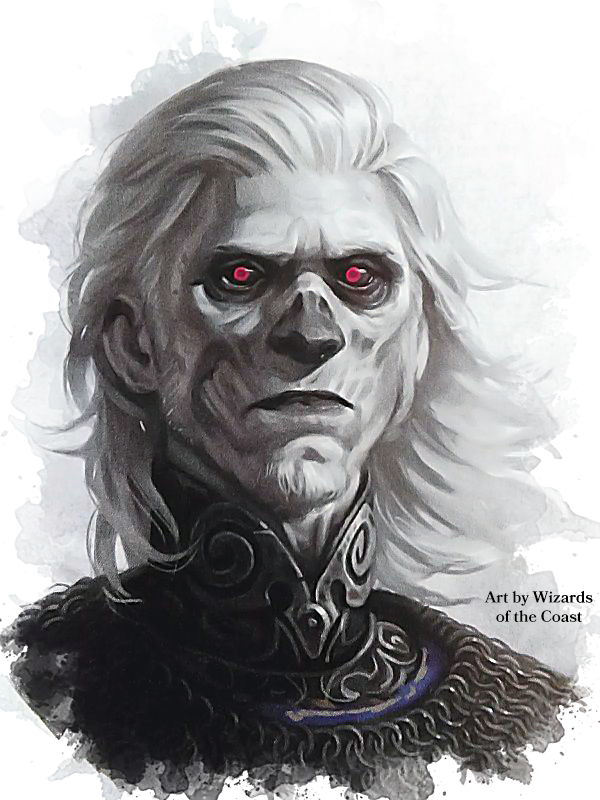
Revenant
When someone is killed in an inhumane and unjust manner, a revenant can be formed if the soul has a strong enough will. A revenant’s purpose in unlife is to seek and destroy those who brought about this injustice. Their bodies usually appear as they did shortly after the individual’s death, but deteriorate over time the longer they spend on the material plane. If they are unable to inhabit their original body, they can use another as a vessel.
Hunger for Revenge
Most revenants have only one year to exact revenge upon their intended mark, usually the one who killed them. They have an otherworldly sense of the state of their quarry. Once their task is complete, or their time runs out, they crumble into dust. Some revenants swear vengeance upon a type of person, such as slavers, rather than a particular individual. These revenants can live for longer, and their bodies are better-preserved. However, they lack the ability to inhabit another body if theirs is destroyed; they only get one chance at revenge.
Revenant Traits
The following traits are shared by player characters who are revenants.
Ability Score Increase. Your Strength and Constitution scores each increase by 1.
Age. Revenants begin their unlife 24 hours after death and don’t age. However, the body they inhabit can deteriorate over time.
Alignment. Their soul still intact, revenants usually hold on to the alignment they had in life, but can be jaded by the experience of death, which would lend itself to a Neutral alignment.
Size. Revenants are the same size as whatever body they inhabit. Your size is Medium.
Speed. Your base walking speed is 30 feet.
Unliving. You are immune to diseases, and you don’t need to breathe, eat, or drink.
Deathly Resilience. You have advantage on saving throws against being poisoned and you have resistance against poison damage.
Regeneration. On your turn, you can use your bonus action to regain hit points equal to 1d6 + your Constitution modifier. The amount of healing increases by 1d6 at 6th, 11th, and 16th levels.
Once you use this ability, you can’t use it again until you complete a short or long rest.
Mark of Vengeance. As an action, you can designate a creature a creature within 30 feet of you that you can see. While the creature is marked in this way, you have advantage on any Wisdom (Perception) and Wisdom (Survival) check you make to find it. Additionally, you know whether or not the creature is alive, even if it is on a different plane of existence.
Hybrid Nature. You have two creature types: humanoid and undead. You can be affected by a game effect if it works on either of your creature types, but are immune to any effect that turns undead.
Languages. You can speak, read, and write Common plus one other language of your choice.
Unshackled Vampire
Higher vampires are typically bound by some greater, darker power that created them and drives them to do dark deeds. Vampire spawn, the victims of a higher vampire, are bound to their master. However, sometimes dark powers will release its creation, or a higher vampire will die, giving its spawn free will again.
Dark Pasts
Although unshackled vampires have their free will, they are still haunted by former ties to dark powers. Grief, anger, and jealousy can still threaten to overwhelm an unshackled vampire if they are not careful to control them. Often, they are also plagued by knowledge of what they have done.
Closer to Human
Unshackled vampire are more distant from the dark entities that gave them power. As a result, unshackled vampires enjoy free will, but its abilities are less potent. At the same time, they also do not suffer the same weaknesses, such as being bound to a coffin.
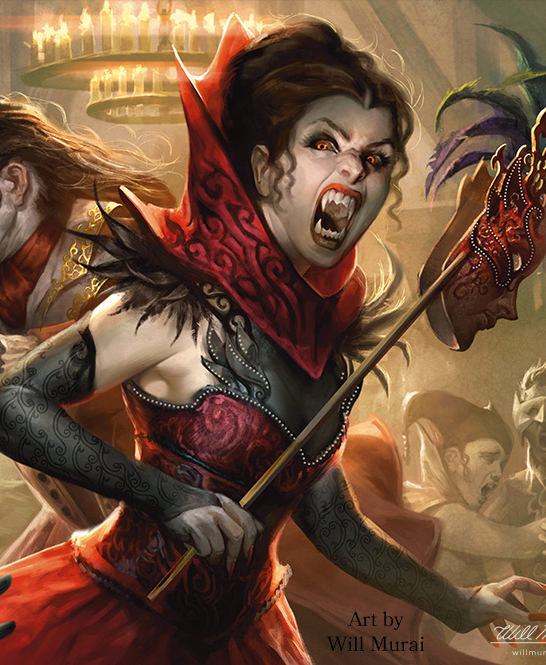
Vampire Traits
The following traits are shared by player characters who are unshackled vampires.
Ability Score Increase. Your Charisma score increases by 1, and your Strength or Dexterity score increases by 1.
Age. Vampires don’t mature and age in the same way that other races do.
Alignment. Vampires, touched by darkness, have a tendency to be Evil, but some overcome the darkness of their past. Evil or not, their fixedness inclines them toward a lawful alignment.
Size. Vampires are the same size and build as humans. Your size is Medium.
Speed. Your base walking speed is 30 feet.
Darkvision. You have superior vision in dark and dim conditions. You can see in dim light within 60 feet of you as if it were bright light, and in darkness as if it were dim light. You can’t discern color in darkness, only shades of gray.
Sunlight Sensitivity. You have disadvantage on attack rolls and on Wisdom (Perception) checks that rely on sight when you, the target of your attack, or whatever you are trying to perceive is in direct sunlight.
Vampiric Resistance. You have resistance to necrotic damage. Additionally, bludgeoning, piercing, and slashing damage you take from nonmagical weapons is reduced by 2. If you have a class feature or feat such as Heavy Armor Master that grants you similar damage reduction, you only benefit from the feature that grants the higher amount of damage reduction.
Vampiric Charm. You can cast the charm person spell once with this trait, requiring no material components, and regain the ability to cast it in this way when you finish a long rest. Charisma is your spellcasting ability for this spell.
Exsanguinate. You can bite and drain blood and life energy from a willing creature, or one that is grappled by you, incapacitated, or restrained. Make a melee attack against a creature that is Small or larger. If you hit, you deal 1 piercing damage and 1d6 necrotic damage. The target’s hit point maximum is reduced by an amount equal to the necrotic damage taken, and you regain hit points equal to that amount. The reduction lasts until the target finishes a long rest. The target dies if this effect reduces its hit point maximum to 0. This ability has no effect on constructs or undead.
Hybrid Nature. You have two creature types: humanoid and undead. You can be affected by a game effect if it works on either of your creature types, with the exception of if you use a class ability that lets you turn undead. If you are targeted by a cleric’s destroy undead ability and you fail your saving throw, you are turned rather than destroyed. Languages. You can speak, read, and write Common plus one other language of your choice.
Subraces
For races that don’t have subrace options, taking on a subrace means making changes to your character’s base traits, as follows. (This supplement provides options only for human, dragonborn, and tiefling characters. Because half-elves and half-orcs have no subrace options, they shouldn’t be used with these subrace rules.)
Human Subraces. If you want to place a human with one of the following subraces, modify human’s Ability Score Increase trait to the following: Three different ability scores of your choice increase by 1. Variant humans cannot use subraces.
Dragonborn Subraces. If you want to play a dragonborn revenant, modify the dragonborn’s Ability Score Increase trait to the following: Your Strength score increases by 1, and your Charisma score increases by 1.
Tiefling Subraces. A prior installment of Unearthed Arcana outlined two tiefling variants that make use of subraces. Use that article to incorporate a subrace from this supplement, replacing the subrace options with one of the following subrace options.
Lycanthropic Bloodline
A creature can become a lycanthrope if it is bitten by one such creature or if one or both of its parents are also lycanthropes. However, sometimes the curse is not passed onto offspring, diluted over generations or with rituals that preserved the humanity of the afflicted. These offspring maintain a connection to the beastial curse that was once strong in their ancestry. This side of them can emerge when they are backed into a corner, or if the individual learns to control it. In this state, the individual gains a measure of lycanthropic resistance, acts in a more instinctual manner. Even when not in this state, the individual can tune into their animal senses to assist in their hunts.
Natural Tracker. You gain proficiency in the Survival skill.
Savage Side. As a bonus action, you can bring forth your inner beast, immediately granting you a number of temporary hit points equal to your proficiency bonus, at the start of each of your turns for the next minute. Attacks with silvered weapons bypass these temporary hit points. While this effect is active, you cannot speak, cast spells, and have disadvantage on all Charisma checks. The effect ends early if you fall unconscious or use an action to end it.
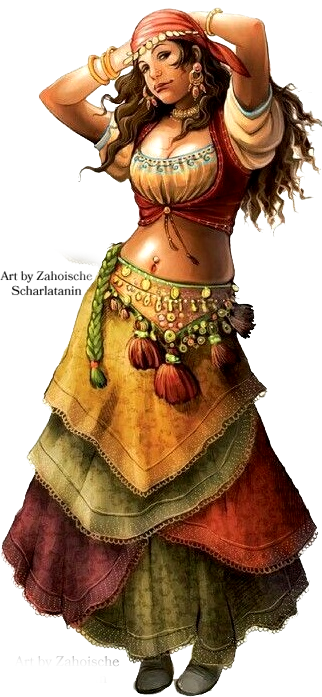
Vistani
The Vistani are travelling humans that wander the fringes of normal civilization, and lands of darkness, including the Dread Domains of Ravenloft and the Shadowfell. They travel in wagons and revel in song, wine, and laughter. Often sporting bright clothing, Vistani typically have dark hair and medium skin. They earn a living as traders, artisans, entertainers, charlatans, and, for a gifted few, genuine fortune-tellers.
Vistani families are very close-knit, and often don’t extend the same courtesy to outsiders, even if they do put on a friendly face. Despite their carefree exterior, Vistani can be very serious. Threats to their families are dealt with harshly and their religious beliefs and superstitions are important parts of their lives. All Vistani have a minor connection to these powers that allow them to bestow curses on those who cross them.
Prerequisite: human
Ability Score Increase. Your Charisma score increases by 1.
Misleading Smile. You gain proficiency in the Deception skill.
Vistani Curse. As an action, you can silently invoke a curse upon a creature you can see within 30 feet of you. The target must succeed on a Wisdom saving throw against a DC equal to 8 + your proficiency bonus + your Charisma modifier or have disadvantage on ability checks and saving throws with the ability of your choice. The curse lasts for 24 hours or until you use this ability again. Once you use this ability, you cannot do so again until you complete a long rest.
Sighted
There are some people who are touched by powerful, otherworldly forces and survive the experience. Not only are they scarred, but some are also left with the unique ability to see past the curtain of the material world. They can sense the supernatural that lurks beyond the veil of most people’s awareness. These individuals are known as sighted.
Possessing the sight is both a blessing and a curse; many have been driven mad by the things which they see with their special vision. Using the sight is also taxing. The more one uses it, the more one is prone to losing their mind. Sighted have a distinctly ethereal appearance. Their skin is much paler than that of their parents, their hair is pure grey or white, and their piercing eyes have mostly white irises with hints of bright blue, purple, or green. Making eye contact with a sighted is viscerally unsettling, similar to someone staring you in the eye from mere inches away.
All sighted share the following characteristics:
The Sight. You can extend your otherworldly senses to perceive the world through a multi-planar lens. You gain the True Sight ability for up to 1 minute. When you close your sight, you must make a DC 12 Wisdom saving throw, on a failed save, you take 1d8 psychic damage. The check is made with disadvantage if you glimpsed any fey, fiends, undead, or necromantic magic with your Sight. Once you use this ability, you can’t use it again until you finish a long rest.
Unnerving. You gain proficiency in the Intimidation skill.
